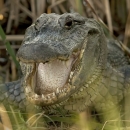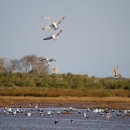About Us
Established in 1983, Big Boggy National Wildlife Refuge is primarily salt marsh salt marsh
Salt marshes are found in tidal areas near the coast, where freshwater mixes with saltwater.
Learn more about salt marsh habitat located along the Gulf Intracoastal Waterway, near the community of Chinquapin. The marsh attracts populations of wintering waterfowl and provides seasonal and year-round habitat for large populations of wading birds, waterbirds, and shorebirds. The refuge along with its companion refuges, Brazoria and San Bernard, were designated an Internationally Significant Shorebird Site by the Western Hemisphere Shorebird Reserve Network. The refuge is a stronghold for the threatened eastern black rail with dense upper saltmarsh prairies that hide the bird from overhead predators.
Dressing Point Island, located 1.5 miles south of the primary refuge in East Matagorda Bay, is a prominent colonial waterbird rookery. The small island comes alive in the spring, as brown pelicans, roseate spoonbills, egrets, herons, gulls and terns find nesting locations. Although battered by wave action and rising sea levels, efforts are underway to restore some of the lost acreage and elevate the island so that it will remain productive for years to come.
Big Boggy is truly “for the birds”. Except for seasonal waterfowl hunting and fishing in Boggy Creek, the 4,526-acre refuge is closed for public use.
Our Mission
The mission of the National Wildlife Refuge System is to administer a national network of lands and waters for the conservation, management and, where appropriate, restoration of fish, wildlife and plant resources and their habitats within the United States for the benefit of present and future generations of Americans.
Our Purpose
Every national wildlife refuge national wildlife refuge
A national wildlife refuge is typically a contiguous area of land and water managed by the U.S. Fish and Wildlife Service for the conservation and, where appropriate, restoration of fish, wildlife and plant resources and their habitats for the benefit of present and future generations of Americans.
Learn more about national wildlife refuge was created for a special purpose. Some were created to protect migratory birds, others to protect threatened or endangered species or unique habitats, while others fulfill another special purpose. Refuges are special places where wildlife comes first. All activities allowed on refuges must be evaluated to make sure each activity will not conflict with the reason the refuge was founded.
From enabling legislation, Big Boggy National Wildlife Refuge serves the following purposes:
- Serve as an inviolate sanctuary for migratory birds. The Migratory Bird Hunting and Conservation Act uses money from Duck Stamp sales to purchase refuge lands. Many lands purchased with Duck Stamp funds were defined as inviolate sanctuaries. These lands, under most circumstances, must be at least partially closed to migratory bird hunting to allow birds a place of refuge and protection where they cannot be harmed.
- For development, advancement, management, conservation and protection of fish and wildlife resources, and their habitats for the benefit of present and future generations of Americans.
Our History
July 8, 1983 – The first parcel was acquired, establishing the refuge.
1992 – Dressing Point Island, located in east Matagorda Bay, was acquired to ensure protection of an important colonial waterbird rookery.
Other Facilities in this Complex
Big Boggy National Wildlife Refuge is complexed with Brazoria and San Bernard National Wildlife Refuges under the umbrella name, Texas Mid-Coast National Wildlife Refuge Complex. There are no facilities on Big Boggy, therefore the refuge is managed out of the San Bernard National Wildlife Refuge Field Office.





